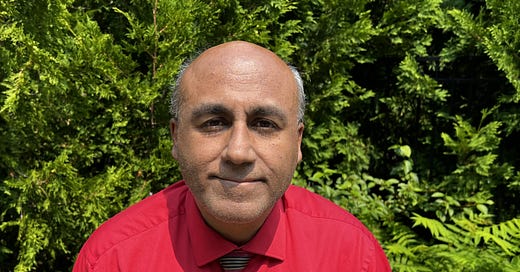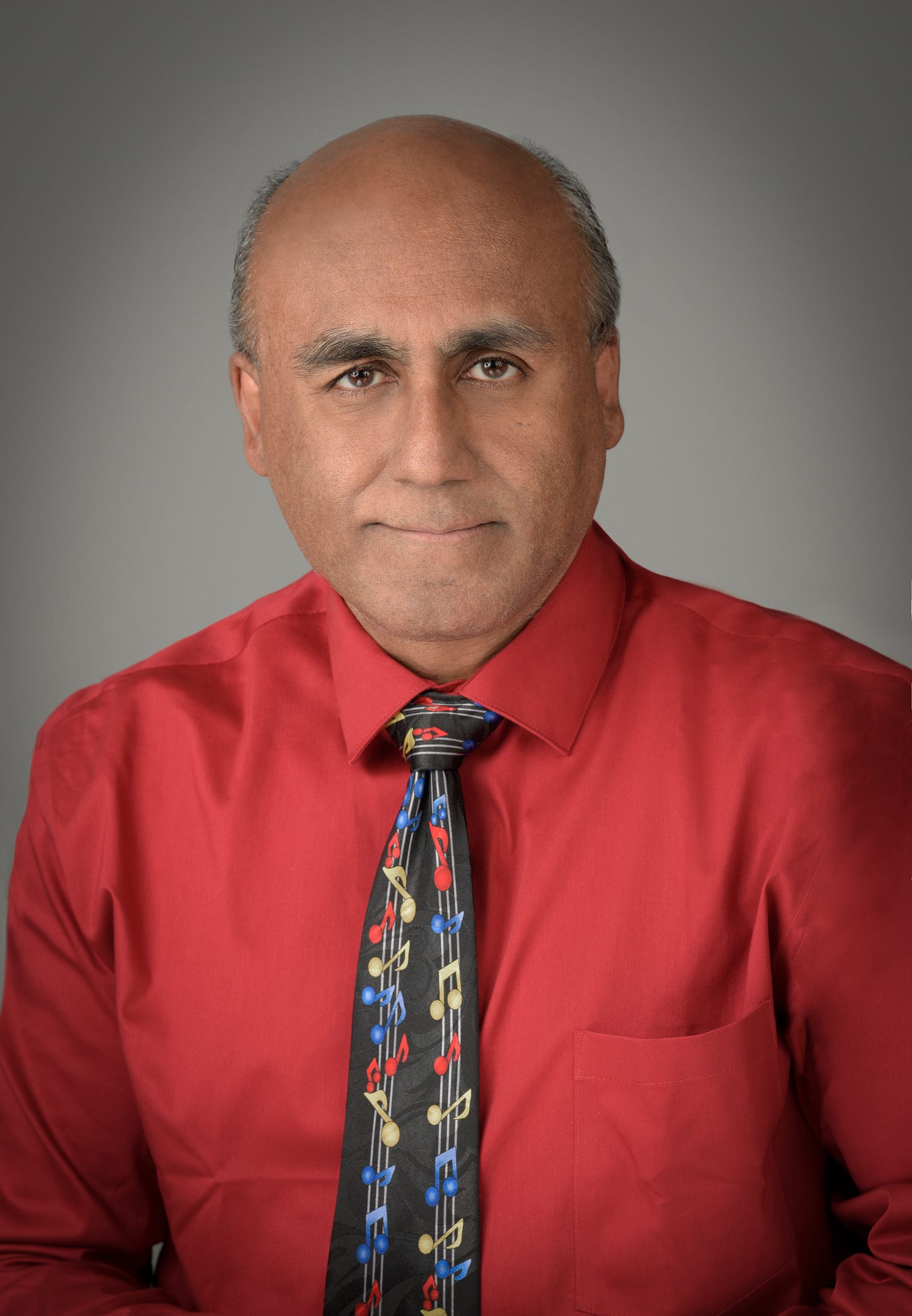OCUFA President Nigmendra Narain Photo Credit: Nigmendra Narain
Some Small Change listeners will remember this podcast first aired May 16, 2024. But with Doug Ford calling an early election this encore presentation is excellent reminder of how Ford is intentionally underfunding universities and colleges in an effort to privatize them — along with every other level of education including childcare, elementary and secondary.
Listen carefully to what Narain, President of the Ontario Confederation of University Faculty Associations (OCUFA), is telling us because it lays bare the fact that we cannot afford another Ford/Conservative mandate that is purposefully destroying the future of our children and this province.
Thanks to robust investing in the 1960s, Ontario established an enviable world class education system spanning elementary right up to post-secondary. And, for the first time in history, public post-secondary education became an affordable reality for boomers.
But, oh, how times have changed!
Ontario is now dead last when it comes to university funding. The Ford government provides $9,890 per domestic full-time student annually (2021). Yet, the national average is $15,807 per domestic full-time student. That deficit of roughly $6,000 per student annually has manufactured a crisis and created instability on Ontario’s university campuses.
Since 2019, cuts to grants have exponentially increased student debt loads. Add, to that, increased domestic tuition fees and it’s easy to understand why many post-secondary graduates have to make the painful decision to not pursue a second degree or graduate studies.
Nigmendra Narain, President of the Ontario Confederation of University Faculty Associations (OCUFA) and lecturer and course coordinator at Western University, focuses on Ford’s systemic, chronic underfunding of Ontario universities and how that is impacting students, faculty and the future of Ontario.
We examine changing domestic demographics and look at the role international students have played especially in light of Doug Ford’s recent statements declaring all spots in Ontario medical schools will be reserved for Ontario students.
What becomes crystal clear, is that the scarcity of university funding affects not only the arts, but also niche programs like diversifying Indigenous sciences as well as programs that target under-serviced communities.
And, it has been completely manufactured by a provincial government bent on “saving tax-payer dollars” by downloading costs onto individuals while encouraging public-private partnerships, or P3s. Same old, same old – destroy and then privatize to “fix” the manufactured crisis in the public sector.
This manufactured crisis is also limiting educational opportunities needed for an increasingly complex, interconnected and global world. One way that’s accomplished is through an abysmal faculty to student ratio. As with any educational system, smaller classes with lower student to teacher ratios provides better outcomes. Ontario’s ratio is currently 34 students to 1 professor. Contrast that with the rest of Canada averaging 23 students to 1 faculty.
To make up for provincial cuts to funding, Ontario’s universities have increasingly turned to exploiting international students. A 2022 Ontario Auditor General’s report noted international students made up 17 per cent of enrollment in Ontario universities and colleges (2021). However, those international students accounted for 45 per cent of tuition revenue. That means, just under 20 per cent of the student population is providing close to 50 per cent of the revenue.
The Ford era of austerity embeds structural exploitation of international students into the system making it virtually impossible for Ontario’s public universities to not only function, but literally survive, without financially abusing these members of their student community.
Limits on international students put in place by the federal Liberals target private universities that often exploit international students by over promising what they can deliver. The only public university impacted by this change in policy was Algoma University with campuses in Sault Ste. Marie and Brampton.
Faced with financial challenges, Algoma University entered into a P3, with Yorkville University, a private, for-profit university. A 2022 report by Ontario’s Auditor General revealed Algoma University was “becoming overburdened by debt in 2016/17.”
To solve the funding crisis, Algoma University began admitting more international students from India to its Brampton campus. The student population increased from approximately 540 students (2020/21) to 5,372 (2023/24). That’s a 900 per cent increase in three years.
The impact is also being felt by faculty who are represented by the Ontario Public Service Employees Union (OPSEU). As course design and delivery is transferred from Algoma University to Yorkville University, non-unionized faculty will be paid much less than faculty represented by OPSUE Local 685.
Historically, P3s have proven disastrous whether they involve hospitals, municipally owned water and waste water systems, or plasma and blood supply and should never be considered a solution to a chronic lack of government funding.
These same outcomes have played out around the world leading some European countries to ban the use of P3s because ultimately the public commons shoulders all of the risks and unforeseen costs, while the private, for-profit portion of the arrangement takes its required monetary share ensuring share holders receive their expected returns. And, as Canadian and European experiences have established, buying your way out of a P3 project gone wrong can keep tax payers indebted to a corporation — often foreign owned — for decades.
The 2014 annual report of the Office of the Auditor General of Ontario was very critical of P3 projects undertaken in the province. In fact, the Ontario Auditor General found that the province spent $8 billion more on P3s than it would have using public procurement. $6.5 billion of that was directly from the higher cost of private financing.
Now, let’s deconstruct Ford’s recent declaration that he wants all spots in Ontario’s medical schools to be reserved for students from Ontario. Ford added that he would be working with the ministry to get rid of the international students who currently make up 18 per cent of medical students.
The yet-to-be-constructed York University Medical School will include hundreds of family physician spots with admission limited to medical students from Ontario. Well, one has to ask, why the Ford government is funding hundreds of new spots for family physician training when 108 reserved spots went unfilled in 2024.
Those 108 vacancies had absolutely nothing to do with international students, but everything to do with intersecting manufactured financial crises including the cost of a post-secondary degree, medical degree, rent, food, transportation plus the added expense of opening and operating an incorporated business, aka family practice, which further limits options for buying a home and starting a family.
And, I haven’t even touched on the impacts this manufactured financial crisis has on professors who bear the brunt of not only larger classes but traveling between multiple universities piecing together short-term contracts that are often bereft of benefits, offer no job security, do not provide a decent standard of living and may not lead to tenure.
But, never fear, Narain and I do discuss what a robust, fully funded university system should look like and how we can get there. However, Narain points out there is one caveat, “We need to have the courage of the 1960s.”
Thanks to everyone who read today’s article and listened to my podcast. With your continued support, a little Nicoll can make a lot of change.
Music: Real Estate by UNIVERSFIELD is licensed under a Attribution 4.0 International License. freemusicarchive.org.
*Be sure to download the Substack app to get the most from your podcast experience.













Share this post